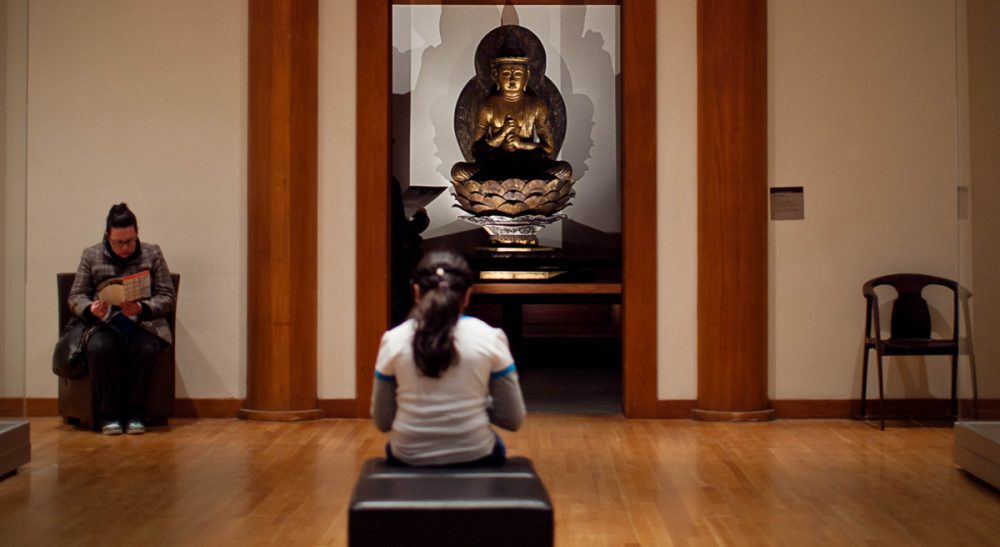Advertisement
The Buddha Wears Prada: A Protest Against MFA Ads

I’ve been trying to get used to the flashy, splashy ads of luxury goods in “MFA Preview,” the members’ magazine of the Museum of Fine Arts. This is something new. This is something bad. I cannot believe that what the MFA rakes in from these ads justifies the discord.
Want art? Open the November/December issue of “Preview” and you’re hit in the eyeballs with a double page spread of a bigger than life gem-encrusted Cartier bauble. The same issue features Director Malcolm Rodgers writing of how “the Museum warmly welcomes you,” his message appearing opposite a full page ad for Sub Zero refrigerators and Wolf stoves (“Experience the Wolf Convection Steam Oven”).
January/February opens with a spread of Hermes, followed by stacks of diamond rings, luxury cars, resorts, and “The Fine Art of Radiators.” Who knew?
The Huntington Avenue doors, restored and thrown open, were to convey a democratic spirit, to welcome people of all backgrounds and incomes. The use of page after page of luxury ads in the member magazine sends the opposite message.
In contrast, a single divided page in the back of the book features small ads for local museums and galleries; it does not assault, but seems informational and appropriate.
When the museum made its dramatic and costly renovations, one of its big public relations pitches was the reopening of the Huntington Avenue entrance, which faces Roxbury, Mission Hill, and the tracks of the MBTA, as opposed to the Fenway entrance, more associated with visitors who arrive in cars. While detractors might say refurbishing and reopening that entrance was much ado about nothing, a symbolic gesture and primarily a design decision, the MFA is an art museum; who better to understand, promote, and employ the use of symbols? And now we have before us the symbols of Cartier, Gucci, and Vacheron Constantin (a watch, not a cheese — the cheese I could get behind).
The Huntington Avenue doors, restored and thrown open, were to convey a democratic spirit, to welcome people of all backgrounds and incomes. The use of page after page of luxury ads in the member magazine sends the opposite message. This is a place for rich people. This is a place where style, not substance, reigns. If you do not know from high fashion and deluxe goods, you are not going to feel comfortable here.

Some reading this opinion will roll their eyes and say, “Oh please, people rush through these magazines, glide past ads and read what they want to,” to which I say, not all people.
I remember a time when I was keenly interested in art, and young, uncertain, and impressionable — as opposed to my present cranky self — when I would have taken these flashy ads so seriously that I would not have gone to the MFA, and not only because I couldn’t afford the admission (currently, $25 for adults, $23 for seniors and students). I would not go where I did not feel welcome.
And yet, I can also say — as a member of the MFA who does not own a Cartier bauble, nor a designer radiator — I feel at ease there. I go alone, as do many, and it's commonplace for strangers to exchange a few words when examining a painting or photograph. The guards are warm, friendly, and polite, and sometimes walk me to the gallery I’m looking for. Some of the employees are snooty, but most are decidedly not, especially those in outreach capacity, like those at the Visitor Center or the ticket desks. The MFA is a welcoming place — once you open the doors and enter.
Some reading this opinion will roll their eyes and say, 'Oh please, people rush through these magazines, glide past ads and read what they want to,' to which I say, not all people.
A few weeks ago, on a cold bleak day, I longed to see paintings. In the starkness of winter, saturated color is a fine thing. I briefly considered getting dressed up (my version of it), but as I have to walk two-miles from home to reach the T, I wore sweats, clunky boots, and my normal grungy parka. During my three hour visit, I studied contemporary photography by Middle Eastern women artists in an almost empty gallery, spent 45 minutes in the bookstore, ate lunch in the cafeteria — bread and cheese from home — while admiring the winter landscape in the museum courtyard. I found a gallery that I had never visited before with Arts & Crafts furniture and Judaica, and sat for a half hour on the wooden banquettes in the Japanese Buddha gallery. Sure, there were lots of dolled-up couples, including those I glimpsed in the windows of the upscale restaurant, but also students in casual attire, and people of all ages in jeans, and even a few ruddy-faced wayfarers in sweats.
The vibrancy inside the museum, what is available if visitors feel welcome — art and architecture, films and talks, music and programs, the helpful staff and interesting visitors — is not represented by these off-putting ads.
Museums have colossal budgets and raising money is a fact of life. But there need to be limits and guidelines to raising money, including those of universal hospitality, coherent communication, and common sense. The advent of ads in “MFA Preview” is a bad idea. No money raised in this way justifies a message of exclusion.
Related:
